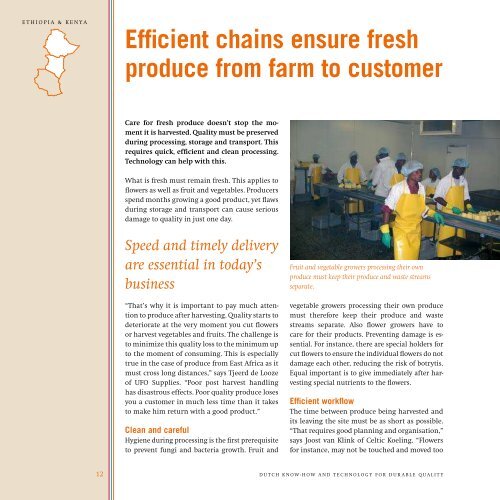Dutch know-how and technology for durable quality - DLV Plant
Dutch know-how and technology for durable quality - DLV Plant
Dutch know-how and technology for durable quality - DLV Plant
You also want an ePaper? Increase the reach of your titles
YUMPU automatically turns print PDFs into web optimized ePapers that Google loves.
E T H I o P I A & K E n y A<br />
2<br />
Efficient chains ensure fresh<br />
produce from farm to customer<br />
Care <strong>for</strong> fresh produce doesn’t stop the moment<br />
it is harvested. Quality must be preserved<br />
during processing, storage <strong>and</strong> transport. This<br />
requires quick, efficient <strong>and</strong> clean processing.<br />
Technology can help with this.<br />
What is fresh must remain fresh. This applies to<br />
flowers as well as fruit <strong>and</strong> vegetables. Producers<br />
spend months growing a good product, yet flaws<br />
during storage <strong>and</strong> transport can cause serious<br />
damage to <strong>quality</strong> in just one day.<br />
Speed <strong>and</strong> timely delivery<br />
are essential in today’s<br />
business<br />
“That’s why it is important to pay much attention<br />
to produce after harvesting. <strong>quality</strong> starts to<br />
deteriorate at the very moment you cut flowers<br />
or harvest vegetables <strong>and</strong> fruits. The challenge is<br />
to minimize this <strong>quality</strong> loss to the minimum up<br />
to the moment of consuming. This is especially<br />
true in the case of produce from East Africa as it<br />
must cross long distances,” says Tjeerd de looze<br />
of uFo supplies. “Poor post harvest h<strong>and</strong>ling<br />
has disastrous effects. Poor <strong>quality</strong> produce loses<br />
you a customer in much less time than it takes<br />
to make him return with a good product.”<br />
clean <strong>and</strong> careful<br />
Hygiene during processing is the first prerequisite<br />
to prevent fungi <strong>and</strong> bacteria growth. Fruit <strong>and</strong><br />
Fruit <strong>and</strong> vegetable growers processing their own<br />
produce must keep their produce <strong>and</strong> waste streams<br />
separate.<br />
vegetable growers processing their own produce<br />
must there<strong>for</strong>e keep their produce <strong>and</strong> waste<br />
streams separate. Also flower growers have to<br />
care <strong>for</strong> their products. Preventing damage is essential.<br />
For instance, there are special holders <strong>for</strong><br />
cut flowers to ensure the individual flowers do not<br />
damage each other, reducing the risk of botrytis.<br />
Equal important is to give immediately after harvesting<br />
special nutrients to the flowers.<br />
Efficient workflow<br />
The time between produce being harvested <strong>and</strong><br />
its leaving the site must be as short as possible.<br />
“That requires good planning <strong>and</strong> organisation,”<br />
says Joost van Klink of celtic Koeling. “Flowers<br />
<strong>for</strong> instance, may not be touched <strong>and</strong> moved too<br />
D u T c H K n o W - H o W A n D T E c H n o l o G y F o r D u r A b l E q u A l I T y<br />
much during bundling. And a vegetable farm<br />
with many different types of produce in the processing<br />
hall requires an efficient workflow. you<br />
there<strong>for</strong>e must think carefully about the design<br />
of your processing <strong>and</strong> packaging lines, <strong>and</strong> intense<br />
staff support safeguards that they work in<br />
the correct manner.”<br />
cold chain<br />
Fresh produce stays better fresh at cold temperatures.<br />
so it is necessary to provide cooling<br />
during storage <strong>and</strong> transport. The temperature<br />
of the produce should be kept at two degrees<br />
celsius <strong>and</strong> never be more than four degrees<br />
celsius. Any deviances from this will have negative<br />
impact on the <strong>quality</strong>.<br />
Interrupting the cold chain should be prevented<br />
at any cost. It is advisable to disinfect the air<br />
to prevent decay caused by bacteria <strong>and</strong> fungi.<br />
There are also specific techniques to prevent<br />
excessive respiration by fresh products during<br />
transport. This will counteract the aging process.<br />
special measuring equipment can trace<br />
Leaves <strong>and</strong> thorns are removed be<strong>for</strong>e packaging.<br />
Preventing damage during transport is essential to<br />
reducing the risk of botrytis.<br />
any potential problems. Applying the right set<br />
of techniques in combination with an efficient<br />
<strong>and</strong> fast logistic chain make it quite well possible<br />
to keep produce fresh.<br />
transport<br />
shipping needs to be well organised. speed <strong>and</strong><br />
timely delivery are essential in today’s business.<br />
“We help growers with all the <strong>for</strong>malities. Documents<br />
must be in order to prevent waits,” says<br />
Moniek van de Put, of J. van de Put Fresh cargo<br />
H<strong>and</strong>ling. “We ship fragile produce. There<strong>for</strong>e<br />
we make sure that the environment is perfect<br />
<strong>for</strong> all the individual products in case of mixed<br />
freights. Growers have to trust us to look after<br />
their produce carefully.”<br />
Providing an efficient chain from harvest to the<br />
moment of sale ensures produce retains its optimum<br />
<strong>quality</strong>. All those concerned can help with<br />
this. Technology <strong>and</strong> communication are vital<br />
to ensuring produce stays fresh, from farm to<br />
customer.<br />
Green Farming P A r T n E r s F o r P E r F E c T s o l u T I o n s E T H I o P I A & K E n y A 3


